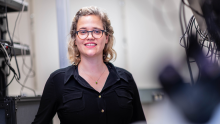A team of UBC physicists and engineers have designed an experiment featuring a trough of flowing water to help bolster a 35-year-old theory proposed by eminent physicist Stephen Hawking.
In 1974, Hawking predicted that black holes--often thought of having gravitational pulls so strong that nothing escapes from them--emit a very weak level of radiation. According to the theory, pairs of photons are torn apart by a black hole's gravitational field--one photon falls into the black hole, but the other escapes as a form of radiation.
In results outlined in the latest issue of Physical Review Letters, a team of UBC researchers led by international postdoctoral researcher Silke Weinfurtner put the test to Hawking's theory by creating a 'white hole' in a six-metre-long flume of flowing water.
Placing an airplane wing-shaped obstacle in the path of the flowing water created a region of high-velocity flow which blocked surface waves, generated downstream, from traveling upstream. The obstruction simulated a white hole, the temporal reverse of a black hole.
The shallow surface waves divided into pairs of deep-water waves, analogous to the photon pairs featured in Hawking's theory. Like in black holes, they showed that the analog would also emit a thermal spectrum of radiation.
"While this creative simulation obviously doesn’t prove Hawking's theory, it does show that his ideas apply broadly," says UBC theoretical physicist William Unruh, part of the team which included European Union Marie Curie Fellow Weinfurtner, undergraduate student Matthew Penrice, Civil Engineering post doctoral fellow Edmund Tedford, and Canada Research Chair in Environmental Fluid Mechanics Gregory Lawrence.
"In addition to their relevance to Hawking's theory, the experiments have raised a number of unanswered fluid mechanics questions of engineering interest," says Lawrence.
"This experiment also exemplifies all of the strengths of UBC's research enterprise--the involvement of students, our international outreach and connections, and a very open, collaborative way of looking at scientific questions," says Unruh.
Physical Review Letters
http://prl.aps.org/abstract/PRL/v106/i2/e021302
Musqueam First Nation land acknowledegement
We honour xwməθkwəy̓ əm (Musqueam) on whose ancestral, unceded territory UBC Vancouver is situated. UBC Science is committed to building meaningful relationships with Indigenous peoples so we can advance Reconciliation and ensure traditional ways of knowing enrich our teaching and research.
Learn more: Musqueam First Nation
Faculty of Science
Office of the Dean, Earth Sciences Building2178–2207 Main Mall
Vancouver, BC Canada
V6T 1Z4


